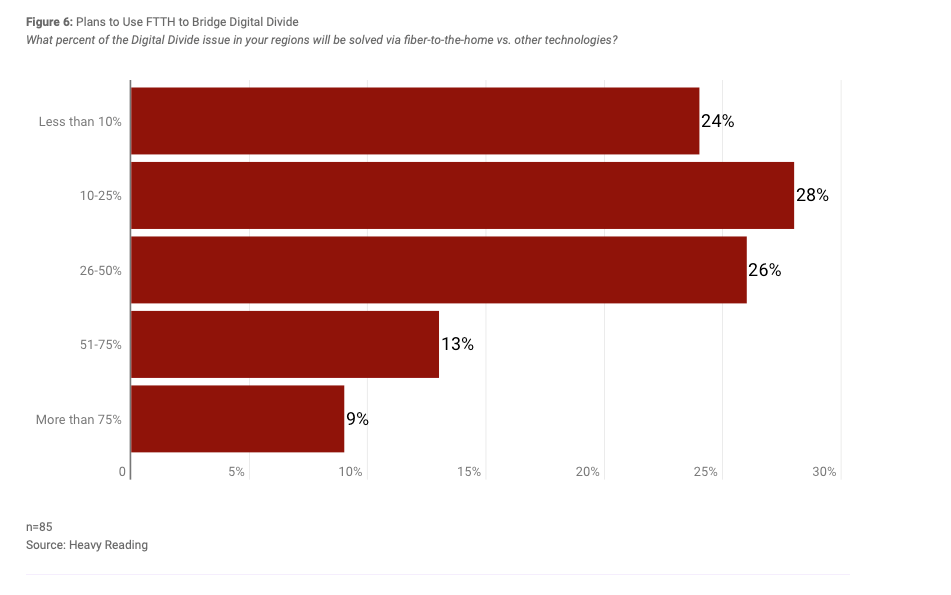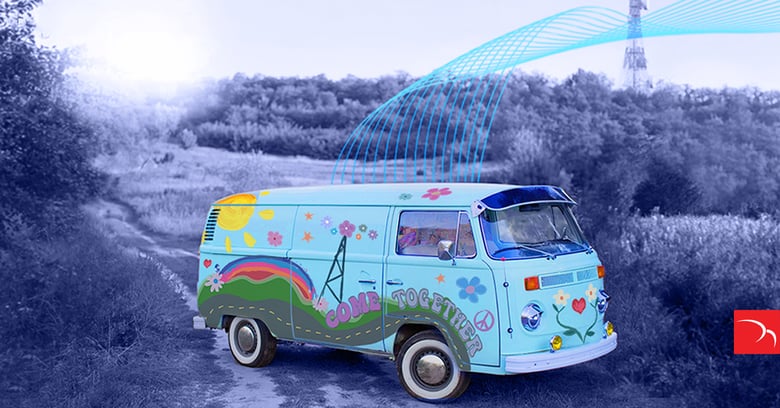High speed connectivity continues to drive innovation and economic growth worldwide. But as network infrastructure upgrades increase capacity and access in urban and suburban areas, our rural communities continue to feel the squeeze of lagging, and often sub-par service. Affordable access to high-quality internet is essential to these communities. But for the world’s populations who remain on the “wrong” side of the digital divide, the chasm continues to expand.
The Digital Divide.
It is a buzzword that’s been tossed around for years – and we’ve heard it time and time again. Pretty much every telco, service provider, integrator, installer, wireless operator, fiber provider, municipality, utility, and yes, even wireless equipment manufacturer, is guilty of throwing it around, and then discussing at length how their company plans to bridge this metaphorical divide. But let’s be honest. No one company or technology can solve this massive undertaking alone. It’s going to take cooperation and a lot of good vibes to truly bridge this giant chasm.
So what exactly IS the digital divide? Simply defined, it is “the gulf between those who have ready access to computers and internet, and those who do not.” Seems pretty clear. There’s an obvious problem, for which there must be a simple solution. Right?
Wrong. Complex problems require multifaceted solutions.
Our brains, as humans, tend to take complex, sometimes difficult-to-swallow realities and oversimplify them, putting them into little categorized boxes that are ready and waiting for a check mark of completion. That’s why we as an industry have all simultaneously clamored at the thought of being “chosen” for government funding to bridge this so-called digital divide, when in reality, we probably need to take one giant unified step back in order to get this job done right. Let’s find a balance and get on the same wavelength first.
These complexities are real and have a ripple effect on those who face little to no connectivity. In this age of digital transformation, we as individuals, and humanity as a whole, depend on fast, reliable internet to live and work effectively in today’s modern society. For those people on the wrong side of the digital divide – according to the FCC, “6% of Americans…more than 19 million people, mostly in rural areas” – are at a major disadvantage. Access to affordable, sufficient broadband would offer the potential to significantly improve their employability, quality of healthcare, and education.
Sure, the term “digital divide” is catchy, the alliteration is there, so you can see why it’s overused but maybe not so well understood. In a world where we already see so much division every day, perhaps the solution to the digital divide needs to come from a place of harmony and unity amongst those of us looking to contribute, rather than the old, ineffective siloed approach. If we truly want to address the challenges associated with the digital divide, we first should be reminded that it is not only about lack of access to high-speed broadband in rural and/or remote communities, but it is also about consumer affordability and adoption of the technology as well. Once this incredibly important detail is understood, we then must look for ways to better work together to connect the under- and unserved.
So, we understand the problem. Not only do 2.7 billion people – or a third of the world’s population to be specific – remain disconnected from the internet, but even if they do have access, they may not be able to afford it. Let’s look a little closer at why.
Fiber and Wireless: The Yin and The Yang
Fiber has earned its reputation as the gold standard for bringing people high speed internet. We will not deny the cosmic shifts in bandwidth, speed, security, and reliability that fiber has brought to the table in recent years. It has been a game changer, no doubt. But platitudes won’t cut it when you have complex problems to solve.
With the unprecedented amount of government funding coming down the pike this year in the United States, and the rather disappointing preference for “all fiber” networks released in the IIJA BEAD rules, we can’t help but notice that our industry is facing a “divide” of our own.
We are not here to say that fixed wireless is superior to fiber. But fiber is expensive and becomes much more so when you’ve only got a handful of subscribers at the end of the fiber run. We, alongside many other wireless companies, have written extensively about the benefits of wireless versus fiber in many circumstances, and we certainly also give fiber its due credit. This is also not simply an “us vs. them” piece, because we’re working to think outside the box and include the best technologies for each individual job. We do, however, want to point out the benefits of wireless that we feel are not often recognized, especially under the NTIA’s BEAD NOFO rules. We think most of us in the industry know when fiber makes sense, and when choosing wireless is the better option, namely:
- An easy & quick installation - you get people connected within days, not months or years (back to the digital divide, this addresses accessibility)
- Much lower costs, which can be passed on as lower monthly fees to rural communities (in reference to the digital divide’s affordability + adoption challenges)
- End-to-end solution, network rollout, and ongoing network monitoring services/support
- Lower latency as compared to long and/or twisting & turning fiber paths (which would very likely be needed to reach these remote locations)
- Fewer permitting challenges, especially with the availability of licensed wireless and CBRS bands
- Dependability, security & redundancy
Alan Breznik recently published a series of four blog articles in Light Reading, looking into how broadband providers plan to close the digital divide. His conclusions, based on a comprehensive study originally published in Heavy Reading, showed interesting results regarding operators’ plans to use fiber-to-the-home (FTTH) as the prime platform they intend to leverage. They found that 78% of operators say that less than 50% of their underserved regions’ digital divide challenges will be solved using FTTH versus other technologies. Although outside the scope of this particular survey, one can prognosticate that a hybrid wireless solution will help close that last mile connectivity gap.

From 2022 Report: Bridging the Digital Divide, Heavy Reading
We certainly hope the government entities responsible for doling out funding do not waste billions on unnecessary fiber overbuilds, simply for the sake of saying they deployed “all fiber networks” to far out rural areas. First, the money will run out before they reach those most vulnerable communities, and second, it will take years to accomplish. The smart, logical, and cost-effective approach is to bring the industry together, a meeting of the minds, if you will, to propose a hybrid approach in bridging the digital divide. Why not utilize fiber where it makes sense financially, and reach those tricky geographies with high-capacity wireless links? The two technologies can easily work hand-in-hand.
Fiber and Wireless - Come Together!
Look, fiber and wireless can (and should) work together beautifully. There is certainly a happy synergy to be had if we do the heavy lifting upfront.
For the vast majority of us on the wireless side, and certainly for WISPs in particular, priority #1 is quickly getting rural, remote, and tribal communities the fast and reliable connectivity they need to fully participate in the world’s digital economy. For many rural service providers, their own communities and the people they serve are one in the same. Who better knows the challenges and needs from a broadband perspective than our local, rural, and tribal partners?
As Scott Imhoff of Cambium Networks put it last year in his article in favor of hybrid networks, “the reality is that fixed wireless broadband must overcome an image issue” to gain traction in the space, and we agree. When someone who may not be an expert on all things networking can physically hold a fiber optic cable in their hand, versus looking at the invisible, proverbial “magic” of wireless technology, they will lean toward what’s familiar – the physical cable. Again, it’s human nature to simplify. As a wireless community, let’s get the word out how groovy wireless technology can be. After all, we are the underdogs in this situation.
Our entire industry, wireless and fiber providers alike, must come together, the best of both worlds, because in unity there is strength. And frankly, we must not lose sight of the reason for this discussion in the first place: to bridge the digital divide.
So let’s think outside the box for a moment. Let’s not get discouraged by all the “fiber first” talk swirling around the internet these days. Let’s pivot, change directions, and seek out ways to reach networking nirvana.
All You Need is Love (and Fast Internet)
We wireless folks have got nothin’ but love for our fiber friends. We think hybrid networks are the way of the future, and the future is now. So how do we get this movement going?
We must all look at every opportunity and be honest and realistic about what will be the most cost-effective and efficient way, in each case, to bring the world’s unserved communities high-speed broadband. We must be vigilant, realistic, and open to new ideas. Let’s also:
- Develop partnerships and consortiums with community hubs, anchor institutions, small town governments, wireless suppliers, and fiber entities to dream up and then write up real, attainable plans and proposals.
- Understand rural funding rules thoroughly. If you are an integrator looking to snag some capital and help bring high speed broadband to your community, regardless if you’re in fiber or wireless, get in touch with us. Rather than chancing it, let’s tap into each other’s expertise so you don’t end up in a fiber overbuild situation, and owing back cash you haven’t even seen yet.
- Continue to join up with wireless associations like WISPA to help petition on behalf of wireless technology and hybrid networks.
- Get involved on a state and local level. Use your expertise and educate others on behalf of the greater good. Dig into network proposals/plans where you foresee a full fiber deployment as impractical, whether outright from a geographical perspective, or within the allotted budget, and let us know where we can help.
- In “fiber first” deployments, consider wireless redundancies. When a cable is cut due to construction, a natural disaster, or any other reason under the sun, you’ve got to keep your network up-and-running. Wireless can provide that safeguard as well.
If you’ve got ideas, we’re all ears. We dig your thoughts and think we can help, too. Let’s turn on, tune in, and NOT drop out. We’ve all got value to add.
Stay groovy ✌️
Want to learn more?


